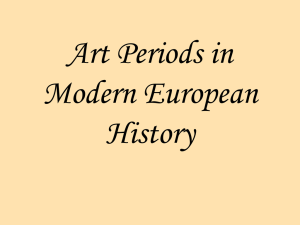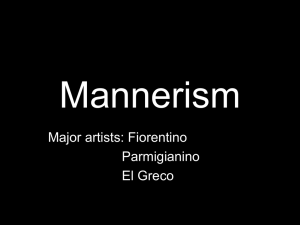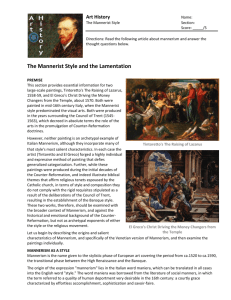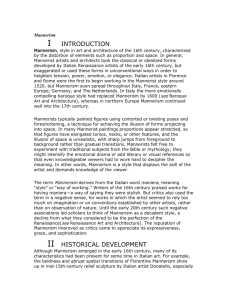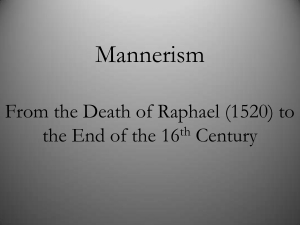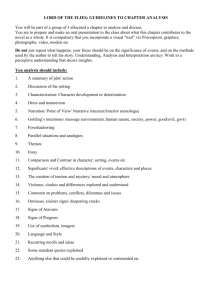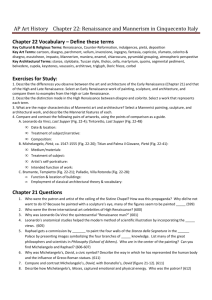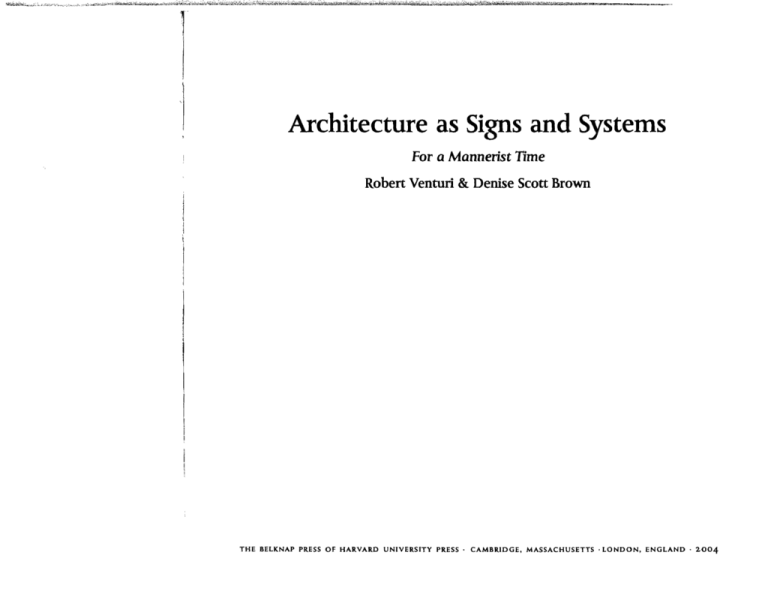
Architecture as Signs and Systems For a Mannerist TIme Robert Venturi & Denise Scott Brown THE BELKNAP PRESS OF HARVARD UNIVERSITY PRESS· CAMBRIDGE, MASSACHUSETTS· LONDON, ENGLAND· 2004
Art & Arch e'J' ,) re Library
Washington u:'li \/(H'si ty
Campus Box 1·,):51
RV:
One Brookin1 8 Dr.
st.
Lg\li,s, !.:0
&:n:W-4S99
DSB:
RV, DSB: Copyright e 2004 by Robert Venturi and Denise Scott Brown
All rights reserved
Printed in Italy
Book Design by Peter Holm, Sterling Hill Productions
Library of Congress Cataloging-in-Publication Data
Venturi, Robert. Architecture as
and systems: for a mannerist time I Robert Venturi and Denise Scott Brown. p. em. - (The William E. Massey, Sr. lectures in the history of American civilization) Includes bibliographical references and index. ISBN 0-674-01571-1 (alk. paper) 1. Symbolism in architecture. 2. Communication in architectural design. I. Scott Brown, Denise, 1931- II. Title. ill. Series.
NA2500.V45 2004
nO'.I-dc22
200404{)313
ttext," for
show his
l them in
lied "that
le most of
'espitemy
to be an
me of our
19 studies,
mth these
ecause if I
1geswon't
Architecture as Sign rather than Space
New Mannerism rather than Old Expressionism
ROBERT VENTURI
,the com­
:tronger­
::ople who
. work and
lity to the
_~.'n
.•. ~~~,'~'"'.".'."_~ _ _ _ _'_''''"'«'''.'''''',_",_.""",~",-,-"
".,-=--_""~
__ , .....
"""'_.~~"',
.._'''''_..._,, __*'...,',.,..,..... __
,u~.,_~
..­
.
-4­
mghai, China. 2003
-and for Shanghai, the mul­
. today, and tomorrow! This
of LED media, juxtaposing
nbolic, and graphic images at
ing. Each is a loft ami. a tower
ibility where dramatic fanfare
hy rather than from formal
A New Mannerism, for Architecture as Sign
So here is complexity and contradiction as mannerism, or mannerism as
the complexity and contradiction of today-in either case, today it's man­
nerism, not Modernism.
At the beginning of the twentieth century, an aesthetic revolution
made sense via a Modern architectUre that was a stylistic adaptation of a
current vernacular/industrial way of building-just as in the mid-fif­
teenth century an aesthetic revolution made sense via a Renaissance
architectUre that was a stylistic revival of an ancient vocabulary, that of
Roman architecture. At the same time, in the Modernist style an indus­
trial vocabulary was paradoxically accommodated within an abstract aes­
thetic, just as in the Renaissance style a pagan/Classical vocabulary was
paradoxically accommodated within an explicitly Christian culture. And
can it now be said that an aesthetic evolution makes sense at the begin­
ning of the twenty-first century, engaging a mannerist architecture
evolved from the preceeding style, that of classic Modernism-just as an
aesthetic evolution made sense in the mid-sixteenth century engaging a
mannerist architectUre evolved from the preceeding style, that of High
Renaissance?
In Complexity and Contradiction in Architecture I referred to
-==",.
1f:,!""mX~i!'/!II1oil!lll!l'!l.I-A-Ii.X
':',\tW /«;"3 m$f'f',U:; :Ii:: =,\\7 ::!;:lL.t.1D"'?:'f-,n:::::i':::-1'"
a complex architecture, with its attendant contradictions, [as] not only a reaction to the banality or prettiness of current architecture. It [can ~====
also represent an] attitude common in ... mannerist periods [and can also be] a continuous strain among diverse architects [in history]. Today this attitude is again relevant to both the medium of architec­
ture and the program in architecture. First, the medium of architec­
ture must be re-examined if the increased scope of our architecture as well as the complexity of its goals is to be expressed. Simplified forms or superficially complex forms will not work. Instead, the variety inherent in the ambiguity of visual perception must once more be A New Mannerism, for Architecture as Sign I ]3
Jj acknowledged and exploited. Second, the growing complexities of
our functional programs must be acknowledged. l
acknowledge unru
plenty and conm
acknowledging a
order so as to be (
In that work, I described, through comparative analysis, historical
examples of mannerist architecture, explicit and implicit, that ac1mowl­
edge complexity and contradiction in their composition, but I did not
prescribe a resultant architecture for the time. This lack of prescription
was noted by Alan Chimacoff and Alan Plattus as positive in their essay
in The Architectural Record of September 1983.2 But here and now,
through a reconsideration of complexity and contradiction as it currently
evolves, I wish to prescribe a specific direction, if not a style-that of
Architecture as Sign-and describe a specific manner, that ofmannerism,
explicitly appropriate for our time. I shall rely again here on analyses of
historical examples of mannerist architecture and urbanism-plus one
example of our own work-to verify and clarify the evolutionary idea of
mannerism and the complexity and contradiction it inherently embraces.
These characteristics
appropriate for toda)
convention as ordinar
So convention, syst
the first place before
racy's tendency to br<:
dence about knowing
them consistently. Lat
nerist trend in British
It is certainly signif
nerism occurs immedi
tion as a style was mos
here is a definition of
times given up on an<
definition that does n.
our time a bore. Here
that acknowledges and
of today (appropriatel)
WHAT IS MANNERISM?
Mannerism-not discovered or ac1mowledged as a style until the mid­
nineteenth century-is, according to Nikolaus Pevsner, "indeed full of
mannerisms.") And it is by definition hard to define: Arnold Hauser has
written, "It can be rightly complained that there is no such thing as a
clear and exhaustive definition ofmannerism.''4 Is not that an appropriate
acknowledgment for our own era-exemplified by multiculUIralism and
by technologies evolving by leaps and bounds? But here is my attempt at
a definition of mannerism in architecture appropriate for now:
Accommodation
Ambiguity
Boredom
Both-and
Breaks
Mannerism as Convention Tweaked-or as Modified Convention
Acknowledging Ambiguity. Mannerism for architecture of our time
that acknowledges conventional order rather than original expres­
sion but breaks the conventional order to accommodate complexity
and contradiction and thereby engages atnbiguity-engages atnbi­
guity unatnbiguously. Mannerism as complexity and contradiction
applied to convention-as acknowledging a conventional order that
is then modified or broken to accommodate valid exceptions and
Chaos
Complexity
Contradiction
Contrast
Convention broken
Deviations
74 I Robert Venturi
.~
~ growing complexities of
edged.
acknowledge unambiguous ambiguities for an evolving era 'of com­
plexity and contradiction-rather than acknowledging no order or
acknowledging a totality of exceptions or acknowledging a new
order so as to be original.
l
nparative analysis, historical
t and implicit, that acknowl­
r composition, but I did not
me. This lack of prescription
Ittus as positive in their essay
198 3.2 But here and now,
d contradiction as it currendy
:ction, if not a style-that of
lC manner, that ofmannerism,
~ely again here on analyses of
me and urbanism-plus one
larify the evolutionary idea of
liction it inherendy embraces.
These characteristics are what can distinguish a mannerist approach
appropriate for today from a N eomodernist .approach, which abhors
convention as ordinary and adores originality as anything to be different.
So convention, system, order, genericness, manners must be there in
the first place before they can be broken-think of the British aristoc­
racy's tendency to break the rules of etiquette in order to imply confi­
dence about knowing them so well and therefore ease in not following
them consistendy. Later I shall describe what I consider a parallel man­
nerist trend in British architecture throughout its history.
It is certainly significant that the most vivid manifestation of man­
nerism occurs immediately after the High Renaissance, where conven­
tion as a style was most explicit and therefore most vividly breakable. So
here is a definition of mannerism where convention is inherent but at
rimes given up on and made thereby exceptionally unconventional-a
definition that does not involve originality or revolution, which is for
our rime a bore. Here is a list of elements of a mannerist architecture
that acknowledges and accommodates the complexity and contradiction
of today (appropriately, in no order except alphabetical):
ISM?
Iged as a style until the mid­
)laus Pevsner, "indeed full of
to define: Arnold Hauser has
'it there is no such thing as a
m.»4 Is not that an appropriate
Hfied by multicn1turalism and
:lds? But here is my attempt at
appropriate for now:
Accommodation Ambiguity Boredom' Ir as Modified Convention
Both-and Breaks Chaos Complexity Contradiction Contrast Convention broken Deviations for architecture of our time
-ather than original expres­
o accommodate complexity
ambiguity-engages ambi­
mplexity and contradiction
Ig a conventional order that
Iodate valid exceptions and
..
A New Mannerism, for Architecture as Sign I 15
-..-~......--~. -....•-.-"~--...---..
.. .- ..•.•.
- ..---...
-.---.- .
..,.:;-
Difficult whole
Discontinuity
Disorder
Dissonance
Distortion
Diversity
Dualities
Dumbness
Eclectic
Everyday
Exceptions
Generic broken
Imbalance
Inconsistency
Incorrect
Inflection
Irony
Jumps in scale
Juxtapositions
Layering
Meaning
Monotony
Naivete
Obscurity
Ordinary
Paradox
Pluralism
Pop
Pragmatism
Reality
Scales (plural)
Sophistication
Syncopation
Tension
76 I Robert Venturi
Terribilitli
Vernacular
Wit
Wrestling
I refer here not to tln
ture, for example, which
matique inconsistency of
which ends up as abstra
concerning what mannel
Contorted
Excessive
Ideological
Mannered
Minimalist
Picturesque
Polite
Willful
There are two kinds
acknowledged: Explicit 3..J
ular style of a particular
Italy in its purest and pre,
be pure-and spelled the
spelled with a small m, re:
in varying historical eras
either naive or sophisticat
Explicit Mannerism is ,
Giulio Romano, acknowl€
But it also embraces the ar.
Implicit mannerism I also
teristic of much English :
Lutyens--or was he explic
architecture, from Glouce:
"lI'-"
Terribilicl Vernacular WIt Wrestling I refer here not to the total inconsistency of recent Decon architec­
ture, for example, which ends up as total consistency, and not to the dra­
matique inconsistency of current Neomodern architecture, for example,
which ends up as abstract sculpture. So here is a further list of notes
concerning what mannerism is not:
Contorted Excessive Ideological Mannered Minimalist Picturesque Polite Willful
There are two kinds of mannerism in architecture that can be
acknowledged: Explicit and Implicit. Explicit might refer to the partic­
ular style of a particular period, that of the mid-sixteenth century in
Italy in its purest and predominant form-to the extent mannerism can
be pure-and spelled therefore with a capital M. Implicit mannerism,
spelled with a small m, refers to what can be called traces of mannerism
in varying historical eras and varying places and can be interpreted as
either n:ilve or sophisticated in its manifestation.
Explicit Mannerism is exemplified in the sixteenth-century work of
Giulio Romano, acknowledged as tbe Mannerist architect by historians.
But it also embraces the architectural work ofMichelangelo and Palladio.
Implicit mannerism I also find to be an enduring and endearing charac­
teristic of much English architecture, from Late Gothic to Sir Edwin
Lutyens--or was he explicit? This is why I adore and learn from English
architecture, from Gloucester Cathedral to Lutyens' manor houses.
A New Mannerism. for Architecture as Sign I 77
122. Gloucester Cathedral, Gloucester, England.
123. Hardwick Hall, Chesterfield, England.
125,126.
Sir Christopher
Wren's st. Paul's
Cathedral, London.
IMPLICIT MANNERISM: EXAMPLES
What I am describing as a mannerism to evolve via complexity and con­
tradiction for our time is more on the explicit side than the implicit
side-it is more capital M -oriented than small m. But I shall first review
some historical examples of implicit mannerist precedent in England that
I have subjectively chosen-many of which were illustrated as examples
of complexity and contradiction in Complexity and Contradiction:
124. Inigo Jones' St. Paul's Church, Covent Garden,
London.
78 I Robert Venturi
• Gloucester Cathedral, whose buttresses expressed within the walls of the nave are essentially structural and horrendously incorrect, within the hyper-rational architectural order that is Gothic. • The architecture of most Elizabethan and Jacobean manor houses, whose tense compositions embrace bearing walls that consist mostly of window openings, as well as compositional dualities, iconographic signage at the scale of biJ
naive or sophisticated? Is
Longleat House, Montae
• Inigo Jones' St. Paul's, C
temple, whose incorrect
• Saint (rather than Sir) C
whose ultimate Baroque
incorrect/ambiguous pel
And Saint Stephen's Wa:
bine convention and oril
125,126,
Sir Christopher
Wren's St. Paul's
Cathedral, London.
127. Sir Christopher Wren'sSt. Stephen's Walbrook,
London.
: EXAMPLES
;:volve via complexity and con­
explicit side than the implicit
;mall m. But I shall first review
erist precedent in England that
::h were illustrated as examples
exity and Contradiction:
expressed within the walls
. horrendously incorrect,
,rder that is Gothic.
I Jacobean manor houses,
19 walls that consist mosdy
onal dualities, iconographic
signage at the scale of billboards, and stylistic ambiguities. Are they naive or sophisticated? Is this Late Gothic or Early Renaissance, as at Longleat House, Montacute House, Hardwick Hall, Hatfield House? • Inigo Jones' St. Paul's, Covent Garden, an adorable church as a temple, whose incorrect Classical proportions create sublime tension. • Saint (rather than Sir) Christopher Wren: viva St. Paul's Cathedral, whose ultimate Baroque dome and drum are supported by a kind of incorrect/ambiguous pendentives inside (naive and sophisticated?)! And Saint Stephen's Walbrook, whose similar configurations com­
bine convention and originality to create tension! A New Mannerism,
for Archiceccure as Sign
I 79
~.
• The fu~ade of Nichola~
a fu~de or is it a tower
rical classical temple bu
J
I.
• Sir John Vanbrugh's B
first day in Europe. 01
or a dilatory pediment
II
~,
~
• Sir John Soane's arche~
hanging rather than su
Similar analyses can bt
their vocabularies but vaL
masters like that of Will
and Lutyens. And could
explicit Mannerists?
Other examples-not E
small m:
128. Nicholas Hawksmoor's Christ Church, Spltalfields,
London.
,'.,
'.
• Luigi Moretti's Casa del
tion of Rome, via the dl
it one building or two ? J
'V"'- ,- .._-...-,.,.:
.fl.....,... .
.
129. Nicholas Hawksmoor's St. George's, Bloomsbury, London.
,
.",,'
_ .-r
1
OJ
,: !~;.",
• The longitudinal eleva!
Francesco Borrornini's :
of the Palazzo di Propa
pose dualities that are t
of the hall as they spati:
.!
oc~,.~~~_~
~!J ' >t;.. -. ~
" ;
..,
~
~II~·"- ;- ·;~.
~.~
~_\'
~1I111;;u;~..;.#~~&1l3i~ _. -~- l!tllil!rai~"I!l1'.
inflection atop each of il
• The plans of Guarino C
Immaculate Conception
Vaccaro's San Gregorio
_0'- • • •
each composes at once {
• Alvar Aalto's church in, '
involving a conventional
well as contradictory lay
130. Sir John Vanbrugh's Blenheim Palace, Woodstock, England
80 I Robert Venturi
131. Sir John Soane's House and Museum, London.
• The fa<;ade of Nicholas Hawksmoor's Christ Church, Spitalfields: is it a fa<;ade or is it a tower? Or his St. George's, Bloornsbury-a symmet­
rical classical temple but with its huge tower halfway down one side. • Sir John Vanbrugh's Blenheim Palace, a building I visited on my first day in Europe. On its front fac;ade: is that a broken pediment or a dilatory pediment? • Sir John Soane's arches inside his house and museum, which are hanging rather than supported. Similar analyses can be made concerning the work-not original in
their vocabularies but valid for their rnaimerist quality-of other British
masters like that of William Butterfield, Charles Rennie Mackintosh,
and Lutyens. And could it be argued that some of these Brits were
explicit Mannerists?
Other examples-not British-that evoke implicit mannerism with a
small m:
lrge's, Bloomsbury, London.
• The longimdinal elevations of the interior of Francesco Borrornini's Baroque chapel of I Re Magi of the Palazzo di Propaganda Fide, whose piers com­
pose dualities that are then mollified by the corners of the hall as they spatially evolve. • Luigi Moretti's Casa del Girasole in the Parioli sec­
tion of Rome, via the duality of its front elevation: is it one building or two? Probably one, because of the inflection atop each of its two segments. • The plans of Guarino Guarini's Church of the Immaculate Conception in Turin and Giuseppe Vaccaro's San Gregorio Barbarigo in Rome, where each composes at once dualities and wholes. • Alvar Aalto's church in, Vuoksenniska, near Irnatra, involving a conventional but asymmetrical nave as well as contradictory layers inside. 132, 133. Francesco Borromini's I Re Magi chapel, Rome.
4useum, London.
A New Mannerism, for Archicecrure as Sign I 81
=
-7rr··
- -: - . . \. "
_ ~ =- ~ ...: l ---=
-
o
"""
10
_.
1.0
-
~= -
H.
10
_I
~
10
135. Guarino Guarini's Church of the Immaculate Conception. Turin, Italv.
134. Luigi Moretti's Casa del Girasc
136. Giuseppe Vaccaro's San Gregorio Barbarigo, Rome.
82 1 Robert Vemuri
fl.
10
~
~j., (
I, ., .. .
--J'..., '! ,r ' "
1
~D>:' (
f
'.~1~- . "
f'K
\::., )
"1'­
~/j
ill i,
J ....
134. Luigi Moretti's Casa del Girasole, Rome.
137, 138. Alvar Aalto's church in Vuoksenniska,
Imatta, Finland.
I­
/l
.
;,.
-........
A New Mannerism. for Architecture as Si9n I 83
• The Gothic church of tl
columns/piers marching
it an example par exceUt
• The mosaic figure of C
Cefalu-it is eloquently
• The slopes of the pedin
of McKim, Mead & Wl
the long elevations and
but the house as iconic:
• And the work of Frank
as in the Pennsylvania j
Bank for the Republic i
demolished-for being
• And Armando Brasini's
Santissima in Rome, fu1
140. Cathedral, Cefalu, Sicily.
dynamic classical comp!
its name is too long.
• And finally the ultimate
Tokyo itself, whose aest
demolitions and its evol
exemplary city of todayl
139. Church of the Jacobins, Toulouse, France.
141. McKim, Mead & White's Low House, Bristol, Rhode Island.
84 I Robert Venturi
• The Gothic church of the Jacobins in Toulouse, whose row of
columns/piers marching mysteriously up the center of the nave make
it an example par excellence of duality-and of ambiguous beauty.
• The mosaic figure of Christ in the apse of the cathedral in
Cefalu-it is eloquently too big.
• The slopes of the pedirnented roof of the Low House, an early work
of McKim, Mead & "White in Bristol, Rhode Island, which occur on
the long elevations and therefore on the "wrong" sides of the house,
but the house as iconic shelter is thereby eloquently enhanced.
• And the work of Frank Furness, teeming with ambiguous dualities,
as in the Pennsylvania Academy of the Fine Arts and the National
Bank for the Republic in Philadelphia. Much of his other work was
demolished-for being mannerist?
~
•~I
~. .
I!"' I~
I!l!!!!II';iI
:~
. ~ -i-~ .
. ~_.J. ~J
c:
.•
.,
• ,m.
_"
'.r1~
/~i..
-,
.
,
-~
'..!I'- ' . '
142. Frank Furness's Pennsylvania Academy of
FIne Arts, Philadelphia.
• And Armando Brasini's Church of the Cuore Irnmacolato di Maria
Santissirna in Rome, full of "too muches" and "too littles" in its
dynamic classical composition inside and out-not to mention that
its name is too long.
• And finally the ultimate example of mannerist urbanism-the city of
Tokyo itself, whose aesthetic of chaos derives from its revolutionary
demolitions and its evolutionary multiculturalism, making it an
exemplary city of today!
143. Frank Furness's National Bank of the
Republic, Philadelphia.
and.
144. Armando Brasini's Church of the Cuore
Immacolato di Maria Santissima, Rome.
A New Mannerism, {or Architecrure as Sign I 85
EXPLICIT MANNERISM: EXAMPLES
Here are some historical examples of explicit Mannerist precedent that
I consider relevant and that "turn me on"-many of which also were
illustrated as examples of complexity and contradiction in Complexity
and Contradiction.
First of all, the architectural work of Michelangelo, whom I love the
most and learn the most from, and whose architectural work in the six­
teenth century, along with Palladio's, I consider explicitly Mannerist. I
can refer to the rear fa<;ade of St. Peter's, with its grand scale confinned
and yet humanized by the height of its false attic windows, which
matches that of the capitals of the adjacent pilasters; to the Laurentian
Library, whose interior pilasters are columns individually niched within
145, 146. Michelangelo's 5t. Peter's, Rome.
86 I Robert Venturi
the wall and whose vestibu
to the fa<;ades of the facu
through their giant and mil
humane monumentality; to
each of whose side walls as
space by implication expan(
ceived as bigger than it is
small space; to the Porta Pi
EXAMPLES
licit Mannerist precedent that
l"-many of which also were
:l contradiction in Complexity
fichelangelo, whom I love the
. architectural work in the six­
msider explicitly Mannerist. I
with its grand scale confirmed
s false attic windows, which
nt pilasters; to the Laurentian
OIlS individually niched within
147, 148. Michelangelo's Laurentian Library,
Florence.
the wall and whose vestibule is a room and a staircase at the same time;
to the fa~ades of the facing buildings of the Capitoline Hill, which,
through their giant and minor orders, glorify vagaries of scale and create
humane monumentality; to the Sforza Chapel in Santa Maria Maggiore,
each of whose side walls as a niche, via its huge radius in plan, makes the
space by implication expand beyond itself, and the space is therefore per­
ceived as bigger than it is and therefore as a monumental as well as a
small space; to the Porta Pia, with its varying combinations of scales and
A New Mannerism , for Architecture as Si9n I 87
-\
;J'i'- - ­ .
-
I
.:
'"
~0.
'"
u
_VI
0
Qj
c­
C
:::c:
-5:
c:
;:
Qj
-£;)
.!::!
::E
ex:
'"
.c:
a>
~
"'
0
CO
CO
i
...<::
<::
'"
::E
...$
Z
«
al
e
&
ra
N
5
Vi
153, 154. Michelangelo's Porta Pia, Rome.
symbols and distorted com
of my controversial book c
And then there is Palla(
architectural good manne
Mannerism via his palaces
a Mannerist period. How
front fa~ade of the gloriou:
defined not by the macho
defines the typical rhythm
small-scale elements-a m
and a statue in relief as a 1
all but one of the five OF
smaller in size than the till
to the three stories of the
rather than more delicate
reversing this convention i
155. Andrea Palladio's Palazzo Valmaran
90 I Robert Venturi
symbols and distorted conventions of vocabulary, illustrated on the cover
of my controversial book of thirty-eight years ago.
And then there is Palladio, known throughout history more for his
architectural good manners via his writings and his villas than for his
Mannerism via his palaces and churches. But to me he is a Mannerist in
a Mannerist period. How else can you acknowledge the corner of the
front fa<;ade of the glorious Palazzo Valmarana in Vicenza, whose bay is
defined not by the macho pilaster of the giant order that consistently
defines the typical rhythmic bay of the rest of the fa<;ade but by several
small-scale elements-a minor-order pilaster at the ground floor level
and a statue in relief as a kind of caryatid at the piano nobile level. Also,
all but one of the five openings vertically composed in this bay are
smaller in size than the three openings of the typical bays that confonn
to the three stories of the rest of the fa<;ade. Corners are usually less
rather than more delicate in wall-bearing fa<;ades-and the effect of
reversing this convention is haunting.
s.GIORGI O M.... GGIORE. A. PALLAD IO. 1566 - 1610
155. Andrea Palladio's Palazzo Valmarana, Vicenza.
IL REDENTORE. VENEZIA. 1576
156. Andrea Palladio's San Giorgio Maggiore, Venice.
157. Andrea Palladio's /I Redentore, Venice.
A New Mannerism, for Arch itecture as Sign I 9 J
And then there are the front fa~ades of two of Palladia's churches in
Venice-San Giorgio Maggiore and n Redentore-teerning with com­
plexities and contradictions that are valid. In each case here is a Christian
church whose interior is based on a Roman basilica (a law court) and whose
exterior is based on a Roman temple--or is it a juxtaposition of temples?
And the combination of basilica and temple(s) makes for beautifully weird
juxtapositions and layerings on the front, where each side of the basilican
fa~ade becomes a bisected fragment of a pedimented temple and where the
buttresses of the interior vault become other kinds of fragments of temple
pediments. And then the temple's front columns become pilasters of var­
ious scales on a wall, and the entrance becomes another little temple fa~de
juxtaposed upon the center. And then the way that some of these elements,
involving forms, symbols, and scales, hit the ground, combining bases, no
bases, and steps, makes for other elements of architectural wonder in a
Mannerist period-the Italian sixteenth century!
MANNERIST ARCHIT TOMORROW'S MULTI AN ARCHITECTURE A mannerist architecl
Japan-whose histori
malism, exemplified
shipped and promote
also Buddhist campI.
ignored by Modernis
there is not only a mi
dictory aesthetic-no
explicitly symbolic ae~
A mannerist archit
from Tokyo-a city a
order. So we go from
rebuilt in the last
grandeur and evoluti
t..E-A~~1
fzn.-
"'j
M~'
0
!
/"k.<
~
"D'"
158. Traditional Japanese interior.
92 I Robert Venturi
159. Japanese Buddhist Temple.
160. "Learning From Tokyo."

